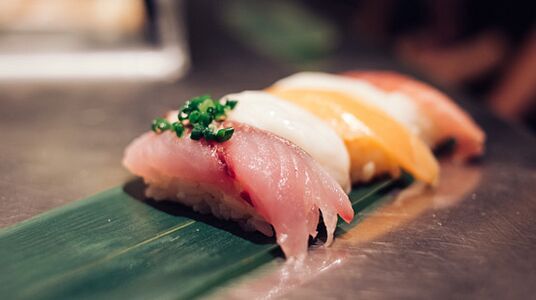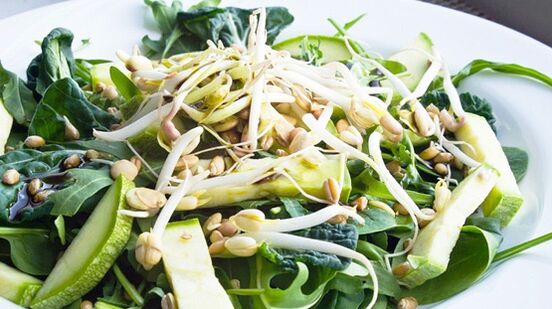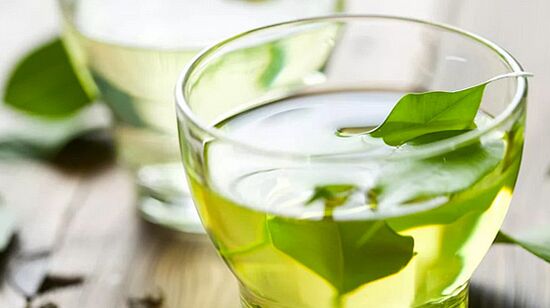
Let's say right away. Most of the "Japanese" diets on the internet have nothing to do with Asian cuisine or the diet discussed below.. Usually, these pseudo-Japanese dietsthey suggest you eat portions of boiled cabbage the size of a bird, a few eggs and 100 grams of meat or fish a day, reduce the number of meals to three and live in this mode for up to 2 weeks. Not! Such a meager diet is not suitable for an active worker.
Why is the Japanese theme and everything under it so popular?
The country of the rising sun will always be attractive and incomprehensible to a European. Perhaps this is due to the fact that for a long time Japan was a closed state to Western civilization. What are they, the Japanese, in our traditional view? They are technological but they believe in spirits. conservative, but invented the "Ganguro" style. restrained, but capable of wild detachment. they value life even in a tiny stalk, but have historically elevated suicide to a remarkable ritual. The islanders gave the world the best magnificent engravings and Pokémon. They are also thin and live long. Why;
You can talk about genetics and physiology or you can answer as follows: we are what we eat.
The article is based on the book The Japanese Diet by Elisa Tanaka.
Traditional ingredients of Japanese cuisine
I lay in the shade
My rice is pushing me
Mountain stream.
Rice
To the Japanese, rice, like bread to us, is "the head of everything. "It is a healthy source of carbohydrates that it does not containGluten free. The people of Japan eat different varieties of rice, but they prefer to eat brown rice cooked with sesame oil.
Fish and seafood

Fish dishes are in second place in volume in the daily diet of the inhabitants of the Land of the Rising Sun. The protein structures of fish meat are complete, digestible and contain essential amino acids necessary for an individual. However, the Japanese do not eat smoked or salted fish - only fresh sea or fresh water. The fat contained in fish is digestible and will not be deposited in your thighs due to bad cellulite, but will give the body full polyunsaturated fatty acids.
Seaweed
Seaweed (also known as seaweed, brown seaweed) is widely used in Japanese cuisine: it is added to rice, fish dishes or soy dishes. Laminaria is a good prevention of thyroid disease, atherosclerosis and heart attack, rich in iodine, minerals and macronutrients. Also, the inhabitants of the Japanese islands use dried seaweed instead of the usual table salt.
Vegetables and legumes
Real Japanese cuisine is impossible without vegetables. This, of course, all kinds of cabbage, radish, garlic, spring onions, cucumbers and tomatoes, eggplants, carrots, peppers, legumes, asparagus, spinach, celery and all kinds of lettuce.
Sprouts and shoots

Valuable sources of nutrients, since cabbages are eaten "alive" - that is, their benefits are not killed by heat treatment. In addition, sprouted grains are more useful than "dormant" grains, because all the processes of life are activated in it.
Advice: Cabbages can be bought in any large supermarket or you can grow them yourself in your window. Take 2 tablespoons of seeds or grains, put them in a container and fill them with water at room temperature so that the liquid level is 6 cm above the surface of the grains. Leave for 7-12 hours, covering the container with gauze. Then drain the water and rinse the beans well. Cabbages should be kept in the dark and can be eaten with salads, soups and as a substitute for greens for side dishes. Just do not make large stocks for future use.
Fruits and berries
Instead of traditional pastries and pastries for us, Asians eat fruit as a dessert. At the same time, it is important to eat fruits and berries in season, ie not strawberries in winter.
Spices and condiments
Curry, black, red and cayenne pepper, anise, turmeric, garlic, horseradish, dill, ginger (fresh and pickled), basil, mustard seed, coriander, cinnamon are usually added to many dishes. But the bay leaf, by contrast, is not used. Salt is also not much appreciated, instead dry seaweed powder (as already mentioned), soy sauce or sesame oil is used.
Green tea

It is believed that tea has many medicinal properties: it strengthens teeth, calms the soul, cures heart disease, neutralizes poisons and helps achieve longevity. The basic principle of Japanese tea consumption is: "Drink - you share, refill - I drink". The second cup of tea is considered the most valuable (especially if you make tea in the cup itself).
Advice: to make the tea fragrant and as useful as possible, first rinse the teapot with boiling water and close the lid to warm it up. Then rinse the tea leaves with lukewarm water and put in a teapot at a rate of 1-2 teaspoons. for a cup of tea, fill the tea leaves with water no hotter than 80 ° C. First, pour water into a third of the teapot and let it boil for 3-5 minutes. Then add half and leave again, but for 1 minute. Then add as much water as you need to drink the tea and let it boil for a minute. The tea is ready.
Tofu (bean curd)
It is a bean curd that provides Asian vegetarians with a complete protein: 240 grams of tofu contains as much protein as two chicken eggs. 100 g of tofu is 20% richer in calcium than 100 g of cow's milk. Soy protein is 95% assimilated, is rich in lysine, calcium, iron, vitamins B, E and K. Tofu is an excellent dietary product and, despite its high nutritional value, bean curd is very low in calories. It has a fewcarbohydratesand without cholesterol. Unlike meat, which is acidic, tofu is alkaline. And nutritionists say that an alkaline environment is more beneficial than an acidic environment and advise you to eat at least 25 grams of soy protein daily.
Benefits of Japanese Diet
Many people can not tolerate a diet simply because diets are very restrictive in taste, sometimes too restrictive in what we eat. Enjoying the taste of food is that joy that can not be abandoned for a long time and without harming well-being or mood. The real Japanese diet consists of delicious dishes made from products that are healthy for the body and are low in calories.
Disadvantages of the Japanese diet
The diet presupposes that you need to learn some recipes of Asian dishes and also requires some adjustments. This diet is technically more complicated than many others, where you just take a few meals and eat for a while or until you get sick.
Studying Japanese cooking techniques can be considered as another skill in your arsenal, such as the ability to sit on a string - it can be amazing, it can be proud.
So, from the kitchen stock you will need:
- Wok, or wok for quick frying or boiling.
- Pans with non-stick coating.
- Double boiler (instead of a double boiler, you can insert a metal strainer in the pan).
- Food processor, mixer?
- Beech, cherry or maple wooden utensils for mixing cooked food: wood does not absorb odors and lasts a long time.
- Wooden skewers or skewers.
For cooking you will need:
- Various varieties of rice.
- Noodles;
- Mushrooms?
- Spices and herbs.
- Sauces: soy, teriyaki, fish, oyster.
Japanese food products should not be a big problem for you, now you can buy them in any supermarket or you can easily replace them with some of our ingredients. Do not be afraid to experiment.
Japanese diet: basic principles

The Japanese diet menu includes many soups and vegetable dishes.. This is a great weight loss strategy because such dishes are low in calories and good for digestion. And the dietary fiber in the composition of vegetables will give your stomach the necessary satiety, so you will not feel torturous periods of hunger.
The number of calories in the menusuitable without the addition of sugar or cream to beverages. Therefore, do not forget to add 16 kcal per 1 teaspoon to your daily calorie intake. sugar and 36 kcal per tablespoon of cream (if using). In other words - sugary coffee - reduce the volume of the main portion of food. Instead of cow's milk, the use of soy is recommended.
The optimal number of calories consumed per day should be between 1200-1400 kcal (for women). This is the number of calories that is enough for the body to live at rest, before eating and at an average ambient temperature. On the one hand, reducing calories to 1200-1400 does not cause abnormal changes in metabolism, on the other hand, it allows you to live your day to the fullest (do not feel collapsed) and fitness classes will be energized by burning your own fat stores.
The risk of diets that reduce calories below 1200:
- With fast weight loss, you will also quickly gain the lost pounds or even more.
- An exhausted diet will negatively affect the condition of the skin, hair and nails and will lead to loss of muscle mass.
- The more muscle you lose, the more your metabolic rate will slow down, making it harder to lose or maintain weight.
The main rules of the Japanese diet
- Do not try to artificially speed up the weight loss process, reducing the number of calories (for the consequences we wrote above). You should not lose more than 1 kg per week.
- Stay in the range of 1200-1400 calories a day. Be sure to supplement with vitamins and minerals.
- Maintain energy balancebetween the energy received and consumed. We get calories from food, with the help of fitness we spend. Violation of this balance, unfortunately, leads to overweight.
- The key to weight loss in the Japanese diet is the variety of foodsand small portions, the transition from fatty meat dishes to a healthy diet based on fruits, vegetables and seafood.
Asian nutritionists have developed a healthy eating pyramid that can be used as a guide when planning your diet and the proportion of certain foods in it.
Tips for effective weight loss in the Japanese diet
- Monitor your physical activity and diet (calorie counting). This facilitates progress.
- Strictly adhere to the selected meal plan and portion sizes.
- Do not think of food as "good" or "bad", enjoy the process of eating.
- If one day you allow yourself to eat high-calorie foods, be sure to reduce the calorie content of your diet the next day.
- Do aerobic exercise.
You may initially lose more than the recommended one pound a week. This is due to the loss of fluid in the body. Then weight loss will be slowed down, but do not despair - this is a completely normal process of healthy weight loss.
Sample Japanese diet menu for 14 days (table)
| Day | Menu for the day | |||
| breakfast | Lunch | Junk food | Lunch and dinner) | |
| a |
|
|
Apple. Calories: 80. |
|
| Total daily calorie intake1428 kcal | ||||
| 2 |
|
|
1 cup of coffee without sugar. Calories: 5. |
|
| Total daily calorie intake1386 kcal | ||||
| 3 |
|
|
1 glass of soy milk. Calories: 150. |
|
| Total daily calorie intake1334 kcal | ||||
| four |
|
|
Calories: 30. |
|
| Total daily calorie intake1424 kcal | ||||
| 5 |
|
|
1 orange (fruit salad) Calories: 141. |
|
| Total daily calorie intake1443 kcal | ||||
| 6 |
|
|
|
|
| Total daily calorie intake1433 kcal | ||||
| 7 |
|
|
1 glass of soy milk. Calories: 150. |
|
| Total daily calorie intake1392 kcal | ||||
| eight |
|
|
1 glass of vegetable juice. Calories: about 70. |
Calories: 576. |
| Total daily calorie intake1424 kcal | ||||
| 9 |
|
|
120 g of fruit yogurt. Calories: 60. |
|
| Total daily calorie intake1440 kcal | ||||
| ten |
|
|
10 young carrots. Calories: 38. |
|
| Total daily calorie intake1303 kcal | ||||
| eleven |
|
|
|
|
| Total daily calorie intake1290 kcal | ||||
| 12 |
|
|
|
|
| Total daily calorie intake1441 kcal | ||||
| 13 |
|
|
1 bowl of cherries. Calories: 31. |
|
| Total daily calorie intake1430 kcal | ||||
| fourteen |
|
|
10 young carrots. Calories: 38. |
|
| Total daily calorie intake1272 kcal |
If you are a little scared of the names of the dishes (which you have probably never cooked) - then do not worry, there are recipes for all the dishes that appear in the Japanese diet.
We save the results
You need to abandon the diet, gradually increasing the number of calories to a level where you could keep your weight unchanged. Just add 100 calories to your diet for 14 days. At the same time, the weight must be controlled. If the scales continue to show weight loss, add another 100 calories over the next 2 weeks and check the scales again. Once the weight has stabilized, you determine for yourself the number of calories needed to maintain a constant weight.
The 100 calories are:
- pork, beef - 80 g;
- 1 boiled chicken breast;
- 150 grams of fish;
- one egg or 2 yolks, or 5-6 proteins.
- a glass of milk;
- yogurt - 125 g;
- a glass of kefir;
- a small slice of bread;
- beans - 25 g (3-4 tablespoons).
- fresh cabbage - 1 kg.
- fresh cucumber - 750 g.
- 3-4 large carrots;
- a large potato tuber.
- 590 g tomatoes;
- 625 g sauerkraut;
- banana - less than 1 pc.
- apricots - 210 g;
- fresh strawberries - 325 g.
- 1 large apple;
- 1 large orange;
- 2 kiwis;
- peaches - 250 g;
- 4 tangerines;
- plum - 200 g;
- 1 grapefruit;
- watermelon - 285 g;
- 1 large pear;
- melon - 190 g;
- 15-20 large grapes.
- any nuts (2 tablespoons) - 15 g.
- noodles - a portion the size of a palm.
- muesli, oatmeal - 1/3 cup;
- porridge in water - 5-6 tbsp. large. per portion.
We hope you succeed! Good luck!
















































































